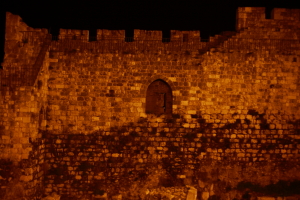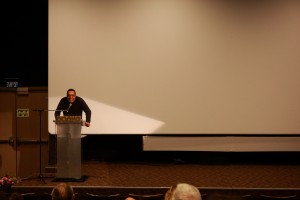 Someone shook my shoulder to wake me up. The chill sent me shivering as I awakened from an uncomfortable slumber. The ground I laid on instantly reminded me of where I was. I held my hand up and looked at my Seiko. The hands glowed dimly. 2 a.m. Time to get up.
Someone shook my shoulder to wake me up. The chill sent me shivering as I awakened from an uncomfortable slumber. The ground I laid on instantly reminded me of where I was. I held my hand up and looked at my Seiko. The hands glowed dimly. 2 a.m. Time to get up.
My buddy waited a few feet away. I stood up, pulled my vest over my shoulders, and checked my weapon. “I’m good,” I whispered and moved away to take over the guard shift. My buddy took his vest off and settled on the same spot on the cold stones I had just freed.
I took a deep breath of the cold air and looked around. No steps or voices were heard from the street below our position. No cars or busses revved their engines on the steep hills. No Muezzin called to prayer through the mosques’ loudspeakers. Only street, house, and yard lights glittered as far as I could see.
I started walking the patrol path toward the Zion gate, careful on the uneven stones beneath my boots. Nighttime sights of the city of Jerusalem, dipped in a soft yellow glow, interrupted by shadows and darkness. Silhouettes of old buildings, stone towers, and curved hills stood against the darker skies like giant waves in a frozen primordial ocean.
I savored the view for a moment, then returned my attention to my mission. No suspicious activity appeared in the vicinity. Really, there was no activity at all. The last people to return to their homes or cars had done so hours ago. I turned back and walked toward my sleeping buddies.
≈≈≈≈≈
We were officer school cadets brought here to reinforce the police securing the influx of visitors during the Passover holiday. Since ancient times, Pesach had been one of the three pilgrimage holidays for Jews. Jews in antiquity made the Mitzvah of Aliya Le-Regel, the deed of making the pilgrimage to Jerusalem from all over the kingdom. Although this tradition was now a relic of the past, the holiday still brought the masses to camp out in parks throughout Israel. Wherever anyone looked it seemed as if the entire population of Israel moved in pilgrimage.
We had arrived in the city a couple of days before to assume our duties. We were divided into small groups of a few soldiers each and dispersed to a variety of missions; manning guard positions in parks, patrolling streets and alleys, stopping mischief, and keeping peace and safety for all. Just the day before, our team patrolled a public park. We walked around in full gear for the entire afternoon and watched people picnic and eat together while children played around. We scanned for potential danger while assuming our presence as a deterrent for troubles.
≈≈≈≈≈
Breathing in the night air, I paced slowly, shivering, and fighting off weariness and boredom. I focused on the valley to the south, with its sprawled village of Silwan and the distant light of the other villages of East Jerusalem. I passed the sleeping pack of my buddies and continued down toward the Dung gate. As I neared the far end of the patrol path, I could see the edge of the Western Wall. Cold air blew from the desert, chilling my body despite my coat. I checked my watch. Only ten minutes had passed since I started my shift. Time crawled at moments like this. I knew checking my watch only slowed it down more. I kept walking.
The physical and mental pressure of combat service sometimes lulled a soldier into a safe mode, limiting one to the task at hand while ignoring or outright missing the bigger picture of the mission. The rigorous routine of security operations is overwhelming, throwing young soldiers into a tight cycle of guard duty, eat, rest, repeat. The passage of day and night becomes indistinguishable as everything revolves around the next call time. You could enter this survival mode of a sort; be ready for duty on time, rest, and sleep when possible, if possible. And don’t forget to eat. Mealtime may fall during sleep time. Still, this week’s assignment came as a welcomed break from the advanced training. We were allowed to slow down to enjoy a change in both pace and scenery.
≈≈≈≈≈
I reached the end of the path and turned to walk back uphill. The cold breeze blowing from the south gained speed in the narrow valley and washed over the wall, carrying desert scents over the ancient stones into the old city. My layers were no match for the onslaught. My misery slowed my patrol time even more. I let my thoughts wander to how many steps I will walk until the shift change and which position was cozier right now; laying on the ground or standing up? I searched for imaginary warmth in the distant shimmering lights. A comforting thought: at least it was not raining. In a few hours, the sun would be up. The temperature would rise. We would have breakfast, get a new assignment, and be somewhere else. More importantly – I wouldn’t be freezing.
Walking slowly, I looked at the dark path ahead of me. The irregular stones revealed nothing but shadows and uncertainty. My sleepy mind dismissed the vision as another reminder of my chilled agony, but it returned and stared at me. Waiting.
In an instant, I jerked to full alert, excited by a vivid insight. The deeper meaning of my being here with my fellow cadets just dawned on me. Our presence took on a sudden bright relevance. This was no longer just another typical security mission. I was not pulling a routine guard duty shift. Standing there in uniform and full combat gear with a gun at hand, I realized, I was a new member of a distinct and honorable group, a part of the company that carried the same duty for well over two millennia. I was a link in a long line of soldiers that continued through era after era, facing different enemies, wearing different gear and armaments, but living the same mission: Jewish soldiers, standing guard on the Wall of the Old City of Jerusalem. I doubted King David’s troops had worn coats as good as the one I had on. I no longer felt cold.
 I am on my way to Jerusalem. I am heading to the Jerusalem Cinematheque on an invitation to attend a screening of a movie produced by a friend. I drive from Tel Aviv, and chose to leave a bit earlier for the trip. Three and a half hours early to be exact. That is a long time. Most days this drive takes about an hour. But this is holiday time, and I chose to play it safe. My early departure proves itself worthy as soon as I leave the neighborhood. Traffic is a nightmare all around. Swarms of cars congest every street, merging in a slow and tense crawl into intersections and struggling to exit them. When I finally make it onto Netivey Ayalon, the highway that crosses Tel Aviv, I find it too overcrowded with traffic. More than an hour of stop and go traffic passes before I get on Highway 1, the road to Jerusalem. The situation there does not fare better. Traffic is mostly a standstill. The logjam gives rise to road stress. Drivers cut in traffic, change lanes, and tailgate for the mere illusion of getting there faster, anywhere they might be heading.
I am on my way to Jerusalem. I am heading to the Jerusalem Cinematheque on an invitation to attend a screening of a movie produced by a friend. I drive from Tel Aviv, and chose to leave a bit earlier for the trip. Three and a half hours early to be exact. That is a long time. Most days this drive takes about an hour. But this is holiday time, and I chose to play it safe. My early departure proves itself worthy as soon as I leave the neighborhood. Traffic is a nightmare all around. Swarms of cars congest every street, merging in a slow and tense crawl into intersections and struggling to exit them. When I finally make it onto Netivey Ayalon, the highway that crosses Tel Aviv, I find it too overcrowded with traffic. More than an hour of stop and go traffic passes before I get on Highway 1, the road to Jerusalem. The situation there does not fare better. Traffic is mostly a standstill. The logjam gives rise to road stress. Drivers cut in traffic, change lanes, and tailgate for the mere illusion of getting there faster, anywhere they might be heading.